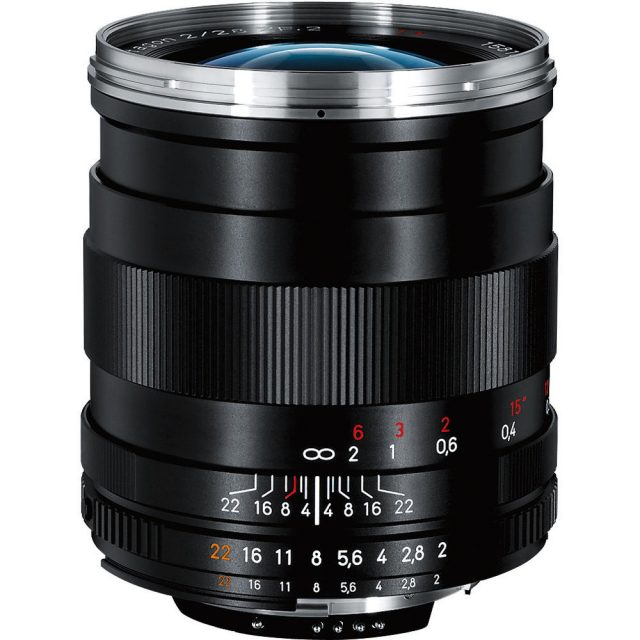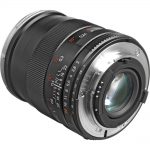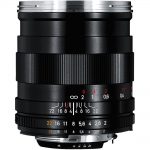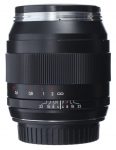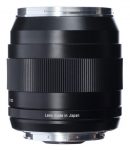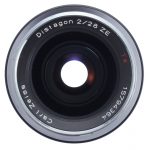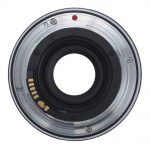Announced
Production status
Original name
Pros and cons
Genres or subjects of photography
Recommended slowest shutter speed when shooting static subjects handheld
Carl Zeiss Classic Distagon T* 28mm F/2 ZE / ZF / ZF.2
Wide-angle prime lens • Digital era • Discontinued
Abbreviations
| T* | Multi-layer anti-reflection coating is applied to the surfaces of lens elements. This anti-reflection coating increases light transmission, eliminates flare and ghosting, and maintains color consistence among all lens models. |
| ZE | The lens is designed for Canon EOS 35mm SLR cameras but can be also used on APS-C SLR cameras. |
| ZF | The lens is designed for Nikon 35mm SLR cameras but can be also used on APS-C SLR cameras. |
| ZF.2 | The lens is designed for Nikon 35mm SLR cameras but can be also used on APS-C SLR cameras. The lens features a built-in CPU which is used to transfer metering data from the lens to the camera. |
Model history
| ■Carl Zeiss Distagon T* 28mm F/2 [AE, MM] | A | 9 - 8 | 0.24m | E55 | 1974 ● | |
| ■Carl Zeiss Classic Distagon T* 28mm F/2 ZE / ZF / ZF.2 | A | 10 - 8 | 0.24m | E58 | 2007 ● | |
Specification


| Optical design: | |
| 28mm | |
| F/2 | |
| 35mm full frame | |
| Canon EF [44mm] | |
| Nikon F [46.5mm] | |
| 75.4° (35mm full frame) | |
| 10 elements in 8 groups | |
| Floating element system | |
| On Canon EOS APS-C [1.59x] cameras: | |
35mm equivalent focal length: | 44.5mm (in terms of field of view) |
35mm equivalent speed: | F/3.2 (in terms of depth of field) |
Diagonal angle of view: | 51.8° |
| On Nikon D APS-C [1.53x] cameras: | |
35mm equivalent focal length: | 42.8mm (in terms of field of view) |
35mm equivalent speed: | F/3.1 (in terms of depth of field) |
Diagonal angle of view: | 53.6° |
| Diaphragm mechanism: | |
Diaphragm type: | Automatic |
Aperture control: | None; the aperture is controlled from the camera (Canon EF) |
| Aperture ring (Manual settings only) (Nikon F, ZF version) | |
| Aperture ring (Manual settings + Auto Exposure setting) (Nikon F, ZF.2 version) | |
| 9 (nine) | |
| Focusing: | |
| 0.24m | |
| 1:4.7 | |
Focusing modes: | Manual focus only |
Manual focus control: | Focusing ring |
| Physical characteristics: | |
| 580g (Canon EF) | |
| 500g (Nikon F) | |
| ⌀72.4×72mm (Canon EF) | |
| ⌀64×68mm (Nikon F) | |
| - | |
| - | |
| Accessories: | |
| Screw-type 58mm | |
| 1502-002 - Bayonet-type round | |
| Not available |
Sources of data
- Manufacturer's technical data.
- SLR lenses: Perfection from Carl Zeiss booklet (PUB. EN_10_025_148III).
- ZEISS lenses for SLR cameras booklet (PUB. EN_10_025_0020II).
Manufacturer description #1
This compact, moderate wide-angle lens is optimized to reduce stray light and reflections and is well suited for difficult lighting conditions. The combination of focal length and lens speed makes it suitable for a broad spectrum of applications. In the half-light of dawn or at dusk, or in interior spaces, the Distagon T* 2/28 lens is the perfect companion for the more daring photographer. It is at its best when the lights are low. Without forcing itself into the foreground, it discovers and highlights the details that would otherwise be lost in the dark.
Manufacturer description #2
Distagon T* 2/28 SLR Lens from Carl Zeiss
High-speed wide angle puts everything else in the shade
OBERKOCHEN/Germany, 2007-09-17.
A new high-speed, wide-angle lens complements the advanced SLR line of lenses from Carl Zeiss for analog and digital 35 mm single lens reflex cameras. With an aperture of 1:2.0 and 28 mm focal length, the Distagon T* 2/28 lens is the ideal bridge between the existing wide-angle lenses with 25 mm and 35 mm focal lengths. It is available as the Distagon T* 2/28 ZF for cameras with the F bayonet and Distagon T* 2/28 ZK for cameras with a K mount. This lens is among the most high-speed optics for these focal lengths and is thus ideally suited for taking pictures in unfavorable lighting conditions. Equipped with manual focus, a high-quality metal casing and floating elements, it provides demanding photographers with a creative, top-class tool with lasting value. As a result, the performance potential of the lens is also available throughout the entire image field even with professional digital cameras featuring full format sensors.
28 mm lenses are primarily used for landscapes, architectural photography and excellent, short-range portraits. It is particularly suited for picture taking indoors – even in natural light. The high image quality down to the close focus range of 0.24 m extends the application range of this lens to include photography of small objects.
The use of floating elements ensures equally impressive image quality in the close-up range as well as at larger distances. With the initial aperture of 1:2.0, photographers enjoy greater creativity through flexible use of the depth of field. This enables them to effectively separate the subject from the background at full aperture and achieve a strong 3D effect. If needed, they can also use the full definition of short focal length optics with smaller apertures over a wide range. High image quality is provided under all conditions despite the extremely high speed.
With its numerous, outstanding properties, the Distagon T* 2/28 from Carl Zeiss is a multi-purpose lens. Thanks to the standard F and K bayonet connections, it can integrated into the corresponding camera systems – with limited compatibility on a case-by-case basis with simple camera models.
This lens will be available for shipping by the end of 2007
Manufacturer description #3
Distagon T* 2/28 ZF Wide-angle Lens from Carl Zeiss
A Photographer's Favorite Tool for Industrial Applications
OBERKOCHEN/Germany, 2007-11-06.
Carl Zeiss has introduced a high-speed, wide- angle lens to meet even the highest demands. The Distagon T* 2/28 ZF – a top-of-the-line lens for challenging industrial applications – is now available. It represents the traditional quality features of high-end lens design: optimum resolution, color fidelity, and a precise mechanical design – combined with optical elements made entirely of glass.
The high maximum aperture of 1:2 and the 28 mm focal length make the Distagon T* 2/28 ZF ideal for industrial applications. It features excellent speed and – due to the complex floating element design – outstanding imaging performance over the entire focusing range.
The ZF lens series from Carl Zeiss is suitable for cameras with F-bayonet (AIS generation) mounts and full-format sensors, thus meeting the standard for high-resolution industrial cameras. The strong, all-metal mechanical system for precise focusing and the reliable aperture setting also meet the high requirements for industrial applications. In addition, the Distagon T* 2/28 ZF offers an exceptionally good price/performance ratio.
Manufacturer description #4
The Expert for Half-light
Carl Zeiss presents the Distagon T* 2/28 with EF bayonet
OBERKOCHEN/Germany, 2009-10-12.
The breaking dawn is a special time for photographers. When the early-morning sun reluctantly chases away the still-glistening dew on the trees, this delicate transition between night and day creates moments of calm and anticipation. But without a tripod at hand, these shots will only succeed with a lens that can handle intense light.
Carl Zeiss today introduces the wide-angle lens Distagon T* 2/28 ZE with EF bayonet, suitable for all analog and digital EOS camera models. With an initial aperture opening of 1:2, it is among the most light-intense of its kind in its focal length. From landscape photography at dawn to interior shots with weak lighting and close-up portraits, the Distagon T* 2/28 ZE offers photographers plenty of room for creativity when a tripod is not used. Following the recent introduction of its two ultra-wide-angle lenses, the Distagon T* 3,5/18 ZE and the T* 2,8/21, the new Distagon T* 2/28 ZE is Carl Zeiss’ first moderate wide-angle lens with EF bayonet.
Despite its high light intensity and complex retro-focus construction, the Distagon T* 2/28 ZE has a compact build. These characteristics make the lens a highly versatile and performance-driven tool for all types of photographers. Even with its wide angle, the lens enables photographers to play fully with an image’s depth of focus. With a wide aperture opening, for example, one can effectively separate the motif from its background. With a small aperture opening, photographers can use the sharpness of the lens system for the entire image range. The floating elements design guarantees high imaging performance each time, from close-ups to infinity, enabling the photo- grapher to make razor-sharp close-up images of even the tiniest objects. Thanks to the Carl Zeiss T* anti-reflective coating and meticulously crafted lenses, the new Distagon T* 2/28 ZE deals effortlessly with reflections and stray light. Brilliant pictures work every time, even under tough lighting conditions such as a breaking dawn.
ZEISS Classic series
Full-frame manual focus lenses developed for ambitious photographers and their wide diversity of applications: macro, landscape, architecture, portrait, journalism, fashion and beauty. Enjoyed an outstanding reputation with photographers all over the world for many years. Characterized by classic appearance and high optical performance. Offer an excellent entry into premium class photography.
- Fast apertures and legendary bokeh;
- Robust, all-metal design;
- 1/2 f-stop intervals with easy-to-feel lock-in positions and exact photometric graduation in ZF.2 lenses;
- Extremely accurate manual focusing.
From the editor
Optically the lens is based on Carl Zeiss Distagon T* 28mm F/2 lens designed for the Contax RTS series of 35mm film SLR cameras.
